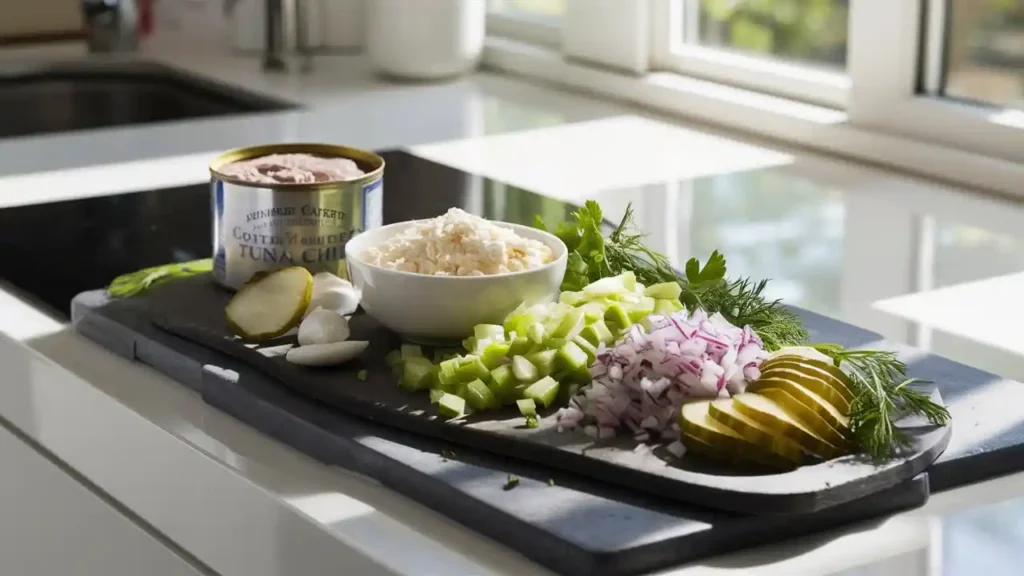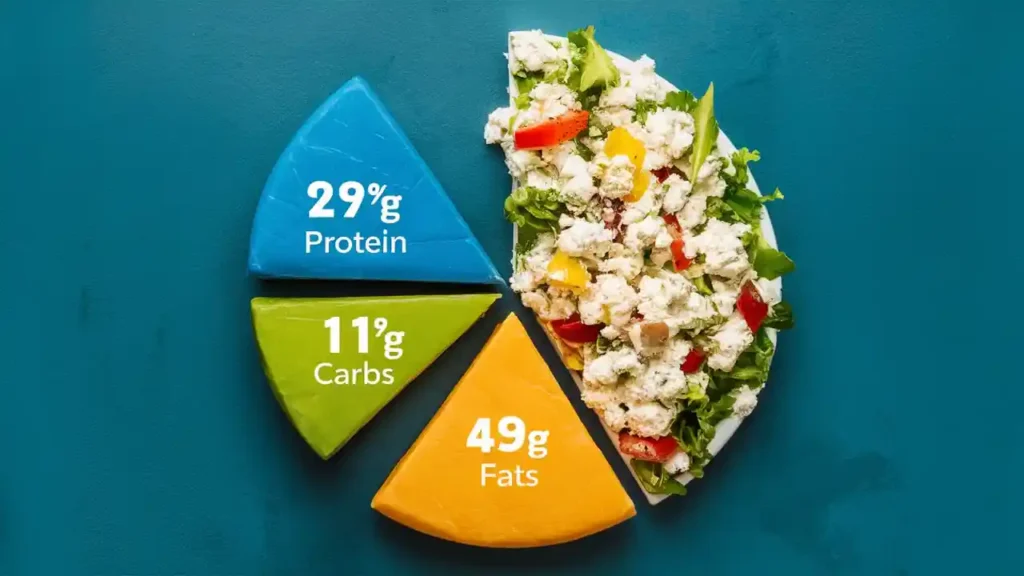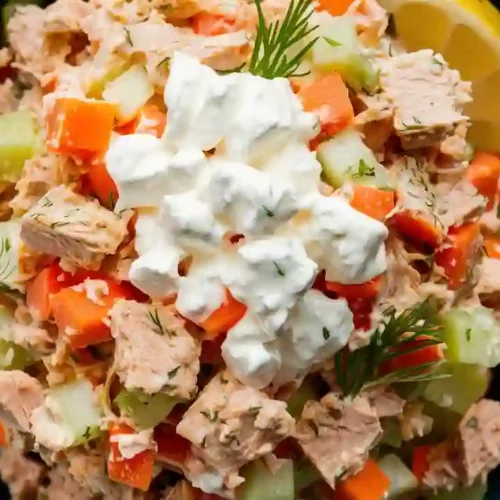Last Updated on March 16, 2025 by Lucas
Looking for a quick, healthy, and delicious meal? This cottage cheese tuna salad combines creamy cottage cheese with protein-rich tuna, offering a satisfying dish suitable for various dietary preferences. With 29 grams of protein per serving, it’s both nutritious and versatile.
Why Choose Cottage Cheese for Your Tuna Salad?
When crafting your tuna salad, substituting traditional mayonnaise with cottage cheese not only lightens the dish but also enhances its nutritional profile. Here’s how:
Health Benefits of Cottage Cheese
- High-Protein Content: Cottage cheese is rich in protein, containing approximately 28 grams per cup. This supports muscle maintenance and promotes satiety, helping you feel full longer.[1]
- Bone Health: It’s a good source of calcium, essential for maintaining strong bones and teeth.[2]
Complementing Tuna’s Nutritional Profile
Combining cottage cheese with tuna creates a synergistic blend of nutrients:
- Omega-3 Fatty Acids: Tuna is rich in omega-3s, which support heart and brain health.[3]
- Vitamins and Minerals: This combination offers a range of essential nutrients, contributing to overall well-being.[4]
Texture and Flavor Enhancements
Incorporating cottage cheese into your tuna salad introduces:
- Creaminess: It provides a smooth texture without relying on mayonnaise.
- Mild Flavor: The subtle taste of cottage cheese complements tuna without overpowering it.
By choosing cottage cheese as a base, you create a tuna salad that’s not only delicious but also aligned with various dietary preferences, offering a satisfying and nutritious meal option.
Essential Ingredients for a Flavorful Cottage Cheese Tuna Salad
Creating a satisfying cottage cheese tuna salad involves selecting ingredients that harmonize in flavor and texture. Here’s a breakdown of the essentials:

Base Ingredients
- Canned Tuna: Opt for solid white albacore tuna. It offers a firm texture and mild flavor, making it ideal for salads.
- Cottage Cheese: Choose small curd, whole milk cottage cheese. Blending it until smooth provides a creamy base without the distinct cottage cheese texture.
Crunchy Additions
- Celery: Finely chopped celery adds a refreshing crunch. Select crisp stalks with a bright green hue for the best texture.
- Red Onion: Diced red onion introduces a zesty kick. To mellow its sharpness, soak the diced pieces in cold water before mixing.
Tangy and Flavorful Components
- Dill Pickles: Chopped dill pickles provide a tangy contrast. For optimal freshness, dice whole, crisp pickles yourself.
- Capers: These small, briny buds introduce a burst of flavor. If you prefer, you can substitute capers with chopped green olives for a different twist.
Preparation Tips
- Ingredient Quality: Using high-quality canned tuna and fresh vegetables elevates the salad’s taste.
- Customization: Feel free to adjust ingredient quantities to suit your personal preferences. For instance, adding a pinch of dried dill or a squeeze of lemon juice can enhance the flavor profile.
By thoughtfully combining these ingredients, you can create a cottage cheese tuna salad that’s both nutritious and bursting with flavor.
Quick Preparation Tips for Your Cottage Cheese Tuna Salad
Crafting a delightful cottage cheese tuna salad is a breeze when you follow these straightforward steps. Let’s dive into some practical tips to ensure your salad is both flavorful and satisfying.

Efficient Ingredient Preparation
- Draining the Tuna: To prevent excess moisture in your salad, it’s essential to drain the canned tuna thoroughly. Here’s how:
- Open the tuna can and press the lid down to squeeze out as much liquid as possible.
- Use a fork to gently press the tuna against the lid, extracting any remaining moisture.
- Transfer the drained tuna to a bowl and fluff it with the fork to separate the flakes.
This method ensures your salad maintains the perfect consistency.
- Mellowing Red Onion’s Sharpness: Raw red onions can have a potent bite. To tone down their intensity:
- Place the diced red onions in a bowl.
- Cover them with cold water.
- Let them soak for at least 15 minutes; longer if you prefer a milder taste.
- Drain and pat dry before adding to your salad.
This simple soak significantly reduces the sharpness, enhancing the overall flavor of your salad.
Mixing Techniques
- Gentle Combining: To keep the textures intact:
- Use a spatula or spoon to fold the ingredients together gently.
- Avoid overmixing, which can lead to a mushy consistency.
- Adjusting Consistency: Depending on your preference for creaminess:
- Add more cottage cheese for a richer texture.
- If you desire a lighter option, incorporate Greek yogurt.
- For a tangier kick, consider mixing in a bit of Dijon mustard.
Flavor Adjustments
- Seasoning: Enhance the taste with:
- Salt and freshly ground black pepper to your liking.
- A pinch of cayenne pepper if you enjoy a hint of heat.
- Fresh Herbs: Introduce a burst of freshness by adding:
- Chopped dill for a classic touch.
- Parsley for a clean, vibrant flavor.
These herbs not only elevate the salad’s taste but also add a pop of color.
By incorporating these tips, you’ll create a cottage cheese tuna salad that’s both delicious and tailored to your preferences. Enjoy crafting your perfect bowl.
Serving Suggestions and Variations for Your Cottage Cheese Tuna Salad
Your cottage cheese tuna salad is not just a meal; it’s a canvas for your culinary creativity. Let’s explore some delightful ways to serve and customize it:

Serving Ideas
- Whole-Grain Crackers: Pair your salad with whole-grain crackers for a satisfying snack that combines crunch with creaminess.
- Lettuce Wraps: For a low-carb alternative, spoon the salad onto large lettuce leaves, wrap them up, and enjoy a refreshing bite.[5]
- Mixed Greens Bed: Serve the salad over a bed of mixed greens for a light yet fulfilling meal.
Recipe Variations
- Fruity Twist: Incorporate diced apples or grapes to introduce a touch of natural sweetness that balances the savory elements.
- Curry Flavor: Add a teaspoon of curry powder to the mix for an exotic flavor profile that intrigues the palate.
- Extra Protein: Mix in chopped hard-boiled eggs to boost the protein content and add richness to the salad.[6]
Storage Tips
- Refrigeration: Store any leftover salad in an airtight container in the refrigerator. It will maintain its freshness and flavor for up to 4 days, making it ideal for meal prep.[7]
- Avoid Freezing: It’s best to consume the salad within this period, as freezing can affect the texture and quality of the ingredients.
By incorporating these serving suggestions and variations, you can tailor your cottage cheese tuna salad to suit your taste preferences and dietary needs, ensuring each meal is both enjoyable and satisfying.
Nutritional Information and Benefits
Cottage cheese tuna salad is not just a tasty meal; it’s also a powerhouse of nutrition. Let’s delve into its health benefits and how it supports your well-being.
Caloric and Macronutrient Breakdown
A standard serving of cottage cheese tuna salad typically contains:
- Calories: Approximately 276 kcal.[8]
- Protein: Around 42% of the caloric content, equating to about 29 grams per serving.[9]
- Carbohydrates: Making up roughly 11% of the calories, translating to about 8 grams per serving.[10]
- Fats: Comprising about 13% of the total calories, which is approximately 4 grams per serving.[11]

Dietary Considerations
This salad aligns well with various dietary plans:
- High-Protein Diets: With a significant protein content, it aids in muscle repair and satiety.
- Low-Carb and Gluten-Free Diets: The minimal carbohydrate content and absence of gluten make it suitable for these diets.
Health Benefits Recap
Combining tuna with cottage cheese offers multiple health advantages:
- Muscle Health: The high protein content supports muscle maintenance and growth.
- Bone Strength: Both ingredients are rich in calcium, contributing to bone density and strength.
- Overall Well-Being: Incorporating this salad into your diet provides essential nutrients that support various bodily functions.
By choosing cottage cheese tuna salad, you’re opting for a meal that’s both delicious and beneficial to your health.
Conclusion
Preparing this cottage cheese tuna salad is both simple and versatile. By combining protein-rich tuna with creamy cottage cheese, you create a dish that’s both satisfying and nutritious. Feel free to experiment with different ingredients to suit your taste preferences. For example, adding diced apples or grapes introduces a touch of sweetness, while incorporating curry powder adds an exotic flavor twist. We’d love to hear about your variations and any enhancements you’ve made to the recipe. Share your thoughts and let’s continue to make this salad your own.

Cottage Cheese Tuna Salad
Ingredients
- 1 can 5 oz solid white albacore tuna, drained
- 1/2 cup cottage cheese small curd, whole milk variety for creaminess
- 1/2 cup finely chopped celery
- 1/4 cup diced red onion
- 2 tbsp chopped dill pickles
- 1 tbsp capers
- Salt and pepper to taste
- Fresh herbs like parsley or dill optional
Instructions
- In a medium bowl, combine the tuna, cottage cheese, chopped celery, red onion, dill pickles, and capers.
- Stir gently until well mixed, ensuring all ingredients are evenly distributed.
- Season with salt and pepper to taste. Adjust seasoning as needed.
- Optionally, add fresh herbs like dill or parsley for extra flavor.
- Serve on a bed of greens, on whole-grain crackers, or in a lettuce wrap for a light meal.
Notes
- Calories: 276
- Protein: 29g
- Fat: 4g
- Carbohydrates: 8g
- Fiber: 1g
- Sugars: 3g
FAQs
Does cottage cheese taste good with tuna?
Yes, combining cottage cheese with tuna creates a flavorful and nutritious blend. The mild, creamy taste of cottage cheese complements the rich flavor of tuna, resulting in a satisfying salad.
Can you use cottage cheese instead of mayonnaise?
Absolutely. Using cottage cheese in place of mayonnaise in tuna salad not only reduces fat content but also boosts protein. It adds creaminess without the heaviness of traditional mayo-based dressings.
Does cheese and tuna go together?
Yes, cheese and tuna pair well together. For instance, a tuna melt combines tuna salad with melted cheese on toasted bread, offering a delightful combination of flavors.
How do you make a tuna sandwich with cottage cheese?
To prepare a tuna sandwich with cottage cheese:
Prepare the Tuna Mixture: Mix canned tuna with cottage cheese, finely chopped celery, diced red onion, and seasonings like salt and pepper.
Assemble the Sandwich: Spread the mixture onto whole-grain bread.
Add Extras: Include lettuce, tomato slices, or other preferred toppings.
Serve: Enjoy as a nutritious and tasty sandwich.
When should you not eat tuna?
It’s advisable to limit tuna consumption during pregnancy due to mercury content. Additionally, individuals with certain health conditions or allergies should consult a healthcare provider regarding tuna intake.[12]
Can I eat tuna and banana together?
While there’s no harm in eating tuna and banana together, their flavors are quite distinct. It’s an unconventional pairing and might not suit everyone’s palate.
Can I eat tuna and eggs together?
Yes, combining tuna and eggs is common in various dishes. For example, adding hard-boiled eggs to tuna salad enhances protein content and adds richness.


1 thought on “Cottage Cheese Tuna Salad”